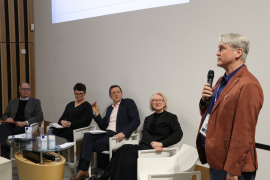

TSE hosted the 17th edition of its Digital Economics Conference on January 9–10, 2025, in Toulouse, featuring a panel discussion titled “Europe’s Innovation Deficit: Is it real, and what can be done about it?”. During the discussion, participants shared their perspectives on this pressing issue, drawing from both their research and personal experiences. The panel was chaired by Paul Seabright (TSE) and brought together three economics researchers—Diane Coyle (University of Cambridge), Monika Schnitzer (University of Munich), and Jean Tirole (TSE)—alongside practitioner Oliver Coste (Coste and Partners).

This “innovation deficit” poses a serious threat to Europe’s strategic autonomy and its influence on the global stage, as well as to the region’s overall economic well-being. Without the productivity gains that boost purchasing power, Europeans’ living standards may be at risk. Even so, many believe it is not too late. Jean Tirole warned, however, that reversing this situation will require strong consensus among policymakers, top research institutions, and industry leaders—enabling the continent to reclaim its place as a world-leading hub of technology and innovation.
 Lack of disruptive investment by European companies. In Europe, sectors that have traditionally been able to afford substantial R&D—such as aerospace and automobiles—have mostly opted for incremental improvements (e.g., refining engines or manufacturing processes) rather than taking on the uncertainty of high-risk, potentially transformative projects. According to Monika Schnitzer, this dynamic stems from a lack of effective competition (which weakens incentives to innovate), fear of cannibalizing existing business, and limited imagination regarding how to meet fast-changing consumer tech demands.
Lack of disruptive investment by European companies. In Europe, sectors that have traditionally been able to afford substantial R&D—such as aerospace and automobiles—have mostly opted for incremental improvements (e.g., refining engines or manufacturing processes) rather than taking on the uncertainty of high-risk, potentially transformative projects. According to Monika Schnitzer, this dynamic stems from a lack of effective competition (which weakens incentives to innovate), fear of cannibalizing existing business, and limited imagination regarding how to meet fast-changing consumer tech demands.
To counter these tendencies, one way could be to redirect support away from struggling legacy firms and toward new or more ambitious ventures—and, where necessary, allowing old or failing companies to exit the market rather than shielding them from competition. A truly procompetitive industrial policy would channel support away from national champions—who often lack strong incentives to transform—and instead target R&D, externalities, and knowledge spillovers.
Inability to attract new disruptive players. Beyond the limitations of legacy sectors, Europe has also struggled to attract or nurture fresh entrants capable of pursuing disruptive innovation. Diane Coyle explained that while the EU is a major economic bloc, market fragmentation—through varied national regulations, financing norms, and language barriers—can limit a startup’s ability to scale across borders. However, according to Oliver Coste, the high cost of failure is one of the biggest deterrents. Because disruptive projects succeed only around 20% of the time, being able to pivot or shut down quickly is crucial. In Europe, labor-market rigidity often means that layoffs require more than one year of negotiations plus one year of severance pays, compared to a few months in total in the United States. This does not necessarily hamper incremental improvements, but it discourages investment in radical innovations, since the financial penalties for failure can be prohibitive. Oliver Coste argued that this mismatch between employment protection and innovation risk is the most significant factor pushing private investment in disruptive tech toward other regions.
one of the biggest deterrents. Because disruptive projects succeed only around 20% of the time, being able to pivot or shut down quickly is crucial. In Europe, labor-market rigidity often means that layoffs require more than one year of negotiations plus one year of severance pays, compared to a few months in total in the United States. This does not necessarily hamper incremental improvements, but it discourages investment in radical innovations, since the financial penalties for failure can be prohibitive. Oliver Coste argued that this mismatch between employment protection and innovation risk is the most significant factor pushing private investment in disruptive tech toward other regions.
To address this, Oliver Coste recommended partial labor-market reforms, such as adopting a “flexicurity” approach for highly skilled R&D roles, so companies can redeploy talent swiftly while still upholding workers’ core rights.

Public funding: ensuring the right priorities. While public funding for European research does exist, several panelists argued that it remains insufficient and often lacks strategic focus. Governments commonly spread resources across member states for political reasons, rather than channeling them toward the most promising proposals. National-level lobbying further complicates efficient EU-wide coordination, and even when European institutions do select projects, they may not always have the specialized expertise needed to identify the most productive projects.
To avoid wasting scarce resources, several panelists stressed that policymakers should first identify high-productivity or high-impact projects—those with genuine potential for major breakthroughs—and only then secure the funding. In practice, this involves entrusting project selection to top research institutions or specialized agencies, ensuring decisions rest on domain expertise rather than political calculations. Some participants also proposed establishing publicly owned enterprises in strategically vital areas to reshape competition, reduce information asymmetries, and promote mission-oriented investments in fields like AI, quantum computing, and next-generation semiconductors.
Looking Forward. Although the obstacles are significant, the panelists remained cautiously optimistic, noting that Europe stands at a crucial juncture. By adopting procompetitive policies, introducing targeted labor reforms, and taking a more strategic approach to public funding for high-potential projects, the continent can still regain its status as a world-class innovation hub. At stake is not only Europe’s economic standing and the welfare of its citizens, but also its ability to preserve its sovereignty and enhance its strategic influence on the international stage.
Thank you to Maxim Sandiumenge for this roundtable resume.
To delve deeper into the factors shaping Europe’s role in the global tech race - how data, policy, investment, competition, and culture influence its ability to compete with the US - listen to episode 6 of our Crossing Channels podcast, "Can Europe ever catch up to the US in technology?"
In this episode, we’re joined by Diane Coyle (Bennett Institute), Jacques Crémer (TSE), and Paul Seabright (IAST, TSE).
Published in TSE Reflect, March 2025
